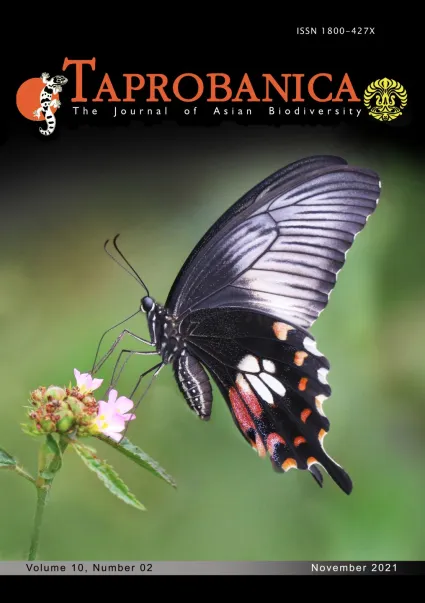

v10i2.264
Volume 10 | Number 2 | November 2021
Short Note
ISSN: 1800-427X (printed)
eISSN: 1800-427X (online)
DOI:10.47605/tapro.v10i2.264
Submitted date: 30 May 2021
Accepted date: 9 September 2021
Published date: 22 November 2021
Pp. 131, pl. 29.
Chromatic leucism in the flap shell turtle, Lissemys punctata from Bangladesh
M.F. Rabbe*, M.M. Alam, M.F. Jaman, M.S. Hossain, K.N.M. Sarafat & A.R. Shome
*E-mail: fazlerabbedu@gmail.com
The spotted flap shell turtle, Lissemys punctata (Bonnaterre, 1789) has a distribution in Bangladesh, India, Myanmar, Nepal and Pakistan. In Bangladesh, this species is widely distributed throughout the freshwater wetlands and the low-lying floodplains, coastal islands, and hill districts. This species is listed in CITES (Appendix II) and protected by Bangladesh Wildlife Conservation & Security Act 2012 (Schedule II), where commercial trade is strictly prohibited. Lissemys punctata has an oval and domed carapace with olive-green colour spotted by dark yellow blotches. The head is also olive green often with yellow blotches, whereas the plastron is whitish or pale yellow. The colour of this species may vary depending on its habitat and defence strategy. Colour aberration in animals may occur due to a lack of melanin. Golden yellow colour aberration (chromatic leucism) is rare in animals, especially in turtles. This might be because of the absence of melanin in the outer dermis. The presence of high xanthophores and yellow pteridine pigments in the skin are also responsible for the golden yellow colour aberration.
Section Editor: Phil Bowles
eISSN: 1800-427X (online)
DOI:10.47605/tapro.v10i2.264
Submitted date: 30 May 2021
Accepted date: 9 September 2021
Published date: 22 November 2021
Pp. 131, pl. 29.
Chromatic leucism in the flap shell turtle, Lissemys punctata from Bangladesh
M.F. Rabbe*, M.M. Alam, M.F. Jaman, M.S. Hossain, K.N.M. Sarafat & A.R. Shome
*E-mail: fazlerabbedu@gmail.com
The spotted flap shell turtle, Lissemys punctata (Bonnaterre, 1789) has a distribution in Bangladesh, India, Myanmar, Nepal and Pakistan. In Bangladesh, this species is widely distributed throughout the freshwater wetlands and the low-lying floodplains, coastal islands, and hill districts. This species is listed in CITES (Appendix II) and protected by Bangladesh Wildlife Conservation & Security Act 2012 (Schedule II), where commercial trade is strictly prohibited. Lissemys punctata has an oval and domed carapace with olive-green colour spotted by dark yellow blotches. The head is also olive green often with yellow blotches, whereas the plastron is whitish or pale yellow. The colour of this species may vary depending on its habitat and defence strategy. Colour aberration in animals may occur due to a lack of melanin. Golden yellow colour aberration (chromatic leucism) is rare in animals, especially in turtles. This might be because of the absence of melanin in the outer dermis. The presence of high xanthophores and yellow pteridine pigments in the skin are also responsible for the golden yellow colour aberration.
Section Editor: Phil Bowles
- List of Articles & Contents





